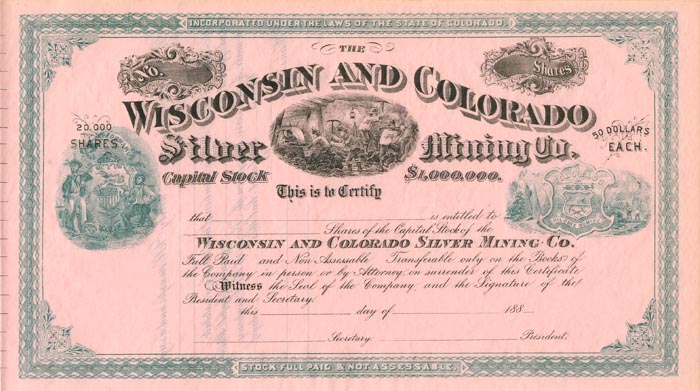Wisconsin and Colorado Silver Mining Co. - Unissued Stock Certificate
Inv# MS1860 Stock
Wisconsin
Unissued Stock. Green on pink paper. Never seen issued.
Silver mining is the extraction of the precious metal silver from the Earth through excavation (i.e., mining).
Silver is found in a native form very rarely as nuggets in placer deposits and veins. It is more commonly combined with sulfur, arsenic, antimony, or chlorine and in various ores such as argentite (Ag2S), chlorargyrite ("horn silver," AgCl), and galena (a lead ore often containing significant amounts of silver). As silver is often found in conjunction with these or alloyed with other metals such as gold, it usually must be further extracted through amalgamation or electrolysis.
Silver mining has been undertaken since as early as the 5th century BCE. As silver is a precious metal often used for coins and bullion, its mining has historically often been lucrative. As with other precious metals such as gold or platinum, newly discovered deposits of silver ore have sparked silver rushes of miners seeking their fortunes. In recent centuries, large deposits were discovered and mined in the Americas, influencing the growth and development of Mexico, Andean countries such as Bolivia, Chile, Argentina and Peru, as well as Canada and the United States.
Silver has been known since ancient times. Silver is mentioned in the Book of Genesis, and slag heaps found in Asia Minor and on the islands of the Aegean Sea indicate that silver was being separated from lead as early as the 4th millennium BC. The silver mines at Laurium were very rich and helped provide a currency for the economy of ancient Athens, where the process involved mining the ore in underground galleries, washing and then smelting it to produce the metal. Elaborate washing tables still exist at the site which used rain water held in cisterns and collected during the winter months.
The Roman took over silver mining in Spain from Carthage after their acquisition of Carthaginian territories there following the Second Punic War. Extraction of silver from lead ore was widespread in Roman Britain very soon after the Roman conquest of the first century AD.
From the mid-15th century silver began to be extracted from copper ores in massive quantities using the liquation process creating a boost to the mining and metallurgy industries of Central Europe.
Vast amounts of silver were brought into the possession of the crowns of Europe after the conquest of the Americas from the now Mexican state of Zacatecas (discovered in 1546) and Potosí (Bolivia, also discovered in 1546), which triggered a period of inflation in Europe. Silver mining required large amounts of mercury to extract the metal from ore. In the Andes, the source was the Huancavelica mercury mine; Mexico was dependent on mercury from the Almadén mercury mine in Spain. Mercury had a very high and adverse environmental impact. Silver was extremely valuable in China, became a global commodity, contributing to the rise of the Spanish Empire. The rise and fall of its value affected the world market.
In the first half of the 19th century Chilean mining revived due to a silver rush in the Norte Chico region, leading to an increased presence of Chileans in the Atacama desert and a shift away from an agriculture based economy. The country of Argentina was named after its silver resources by Spanish conquistadors; Argentina is a Spanish adjective meaning "silvery".
Silver mining was a driving force in the settlement of western North America, with major booms for silver and associated minerals (lead, mostly) in the galena ore silver is most commonly found in. Notable silver rushes were in Colorado; Nevada; Cobalt, Ontario; California and the Kootenay region of British Columbia; notably in the Boundary and "Silvery" Slocan. A silver rush in Idaho produced mines in an area known as Silver Valley, a handful of which are still active today. The first major silver ore deposits in the United States were discovered at the Comstock Lode in Virginia City, Nevada, in 1859.
A stock certificate is issued by businesses, usually companies. A stock is part of the permanent finance of a business. Normally, they are never repaid, and the investor can recover his/her money only by selling to another investor. Most stocks, or also called shares, earn dividends, at the business's discretion, depending on how well it has traded. A stockholder or shareholder is a part-owner of the business that issued the stock certificates.









Ebay ID: labarre_galleries